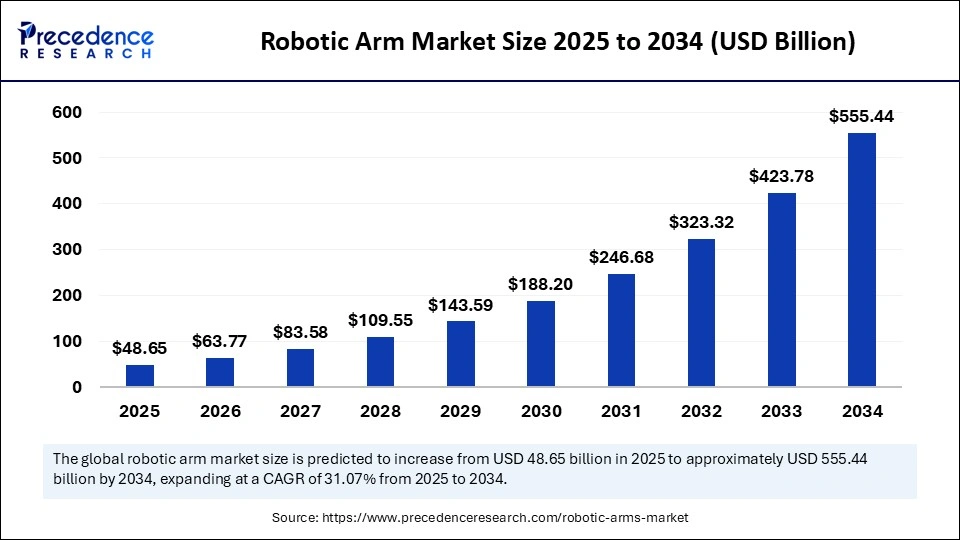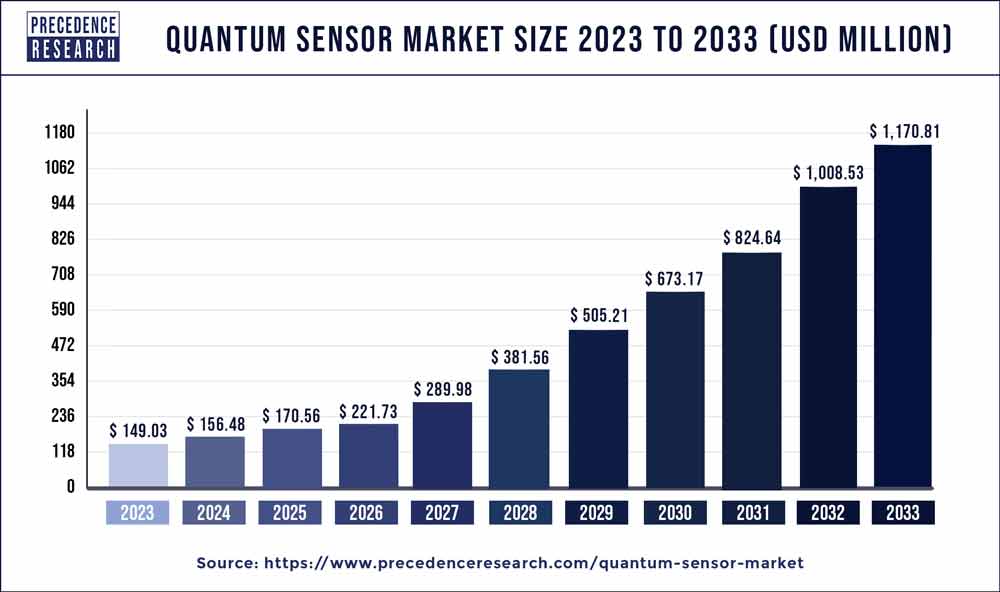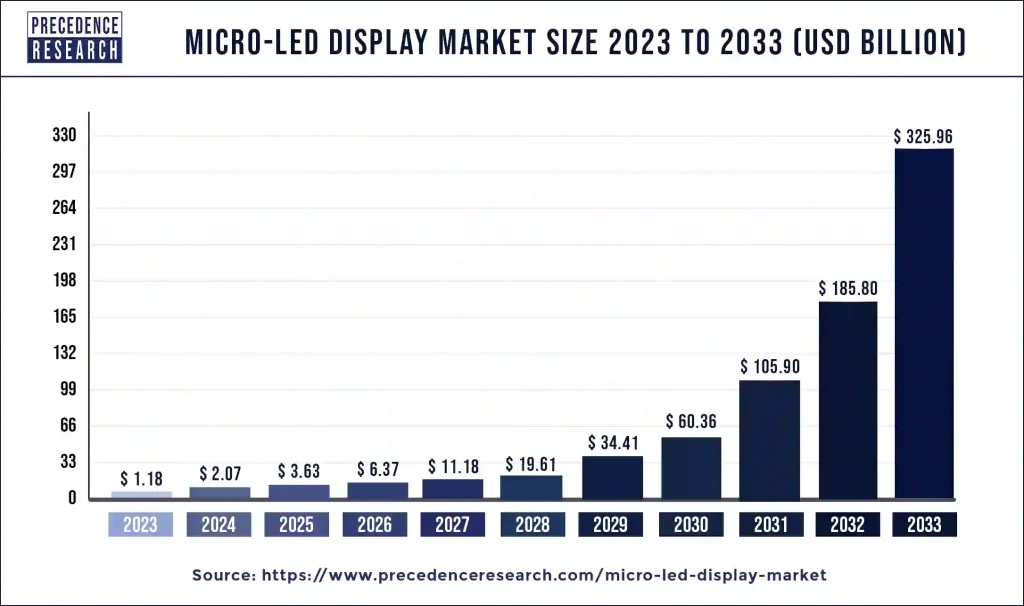Robotics, AI, and Automation Fuel Explosive 31% CAGR Growth Globally
The global robotic arm market size is forecast to escalate from USD 48.65 billion in 2025 to a monumental USD 555.44 billion by 2034, registering a compound annual growth rate (CAGR) of 31.07% between 2025 and 2034.

This surge is driven by intense demand for industrial automation, the rise of Industry 4.0, expanding manufacturing sectors, and sophisticated AI-driven robotic technologies that are transforming logistics, assembly, and production lines worldwide.
Robotic Arm Market Key Insights
-
The robotic arm market is set for a leap, projected from USD 48.65 billion in 2025 to approximately USD 555.44 billion by 2034.
-
Asia-Pacific currently dominates with 50% market share, led by China, Japan, South Korea, and India.
-
The articulated robotic arm segment leads by type, with a 40% share, prized for its adaptability and productivity.
-
Material handling is the leading application, capturing 30% market share due to booming e-commerce and logistics demand.
-
The automotive industry drives end-use, holding 35% share through applications in welding, painting, and assembly.
-
Leading players include ABB Robotics, Stäubli Robotics, Flexiv, Accenture, and Schaeffler AG—with continuous breakthroughs in vision systems, mobile robots, and force-control simulation.
Market Size and Regional Growth
| Year | Global Market Size (USD Billion) | Asia-Pacific Size (USD Billion) |
|---|---|---|
| 2025 | 63.77 | 24.33 |
| 2034 | 555.44 | 280.50 |
The AI Advantage: How Artificial Intelligence Is Reshaping Robotic Arms
AI transforms the robotic arm market by empowering machines to handle complex tasks autonomously, learn from operational data, and seamlessly collaborate with humans to streamline processes. Machine learning algorithms allow robotic arms to adapt to new tasks, optimizing efficiency and reducing human error across manufacturing, healthcare, logistics, and automotive industries.
Beyond basic automation, AI-driven robotic arms enable predictive maintenance, real-time performance analytics, and dynamic adjustment for precision tasks. This evolution is key to addressing labor shortages and achieving cost-effective, high-quality production at scale.
What Fuels Market Growth?
Driven by rapid industrial automation, ongoing technological innovation, and acute labor shortages, the market’s expansion hinges on:
-
Adoption of robotic arms in diverse settings from cleanrooms and hospitals to car factories and e-commerce warehouses.
-
Government initiatives and incentives that encourage automation, especially in Asia-Pacific’s industrial hotbeds.
-
Integration of collaborative robots (cobots) and IoT, particularly in SMEs seeking cost-effective automation solutions.
-
Rising focus on high-speed, accurate, repetitive tasks that demand robotic efficiency and adaptability.
Opportunity and Trend: What Shifts Are Reshaping Robotics?
How does innovation in vision systems unlock new markets?
Recent breakthroughs, like ABB Robotics’ OmniCoreEyeMotion launch, allow robots to perceive surroundings and adapt in real time using any third-party camera or sensor. This flexible, hardware-agnostic solution opens doors for advanced manufacturing, warehousing, and healthcare applications that require dynamic precision and safety.
Why are mobile robots and force-control simulation gaining traction?
Stäubli Robotics and Flexiv are pioneering new technologies, including mobile robots for pharmaceutical cleanrooms and high-fidelity force-control simulation via NVIDIA Isaac Sim. These solutions enable robust automation in sensitive environments and further enhance the deployment of AI-empowered robotics for real-world, high-contact tasks.
What is driving cobot demand among SMEs?
Cobots, designed for safe and interactive work alongside humans, are being rapidly adopted by smaller manufacturers and logistics providers. Their flexibility and cost advantages, combined with AI and IoT integration, make them essential tools for boosting productivity and precision.
Regional and Segment Analysis: Where Is Growth Accelerating?
Which region is setting the pace?
Asia-Pacific’s 50% global market share is driven by rapid industrialization, increasing automation demand, and bold government initiatives. China, Japan, South Korea, and India spearhead new installations, particularly for articulated and collaborative robotic arms in automotive, electronics, and healthcare sectors.
Segment Leaders:
By Type: Articulated robots dominate (40%), while cobots are expected to surge.
By Application: Material handling leads (30%), with dispensing showing significant growth potential, especially for precise chemical and pharmaceutical applications.
By End-Use Industry: Automotive manufacturers hold 35% share, while pharmaceuticals are expanding rapidly for applications that demand strict quality control and contamination reduction.
Breakthroughs: Pioneering Companies and Innovations
Top companies propelling innovation include:
-
ABB Robotics – Advanced vision systems for adaptive robotics
-
Stäubli Robotics – Mobile cleanroom robots for pharma production
-
Flexiv – Force-control simulation powering AI-based robotics design
-
Accenture & Schaeffler AG – Human-robot collaboration and full automation showcased at Hannover Messe 2025
These breakthroughs enable new use cases from automated production lines to precision healthcare and collaborative workplaces.
Robotic Arm Market Companies
- Doosan Robotics
- DENSO Corporation
- FANUC
- KUKA
- Yaskawa Electric Corporation
- Universal Robots
- Epson Robots
- Kawasaki Heavy Industries
- Comau
- Nachi-Fujikoshi Corporation
- Mitsubishi Electric Corporation
- Omron Corporation
- Techman Robot
- AUBO Robotics
- EFORT Intelligent Equipment
- Estun Automation
- Siasun Robot & Automation
Get this report to explore global market size, share, CAGR, and trends, featuring detailed segmental analysis and an insightful competitive landscape overview @ https://www.precedenceresearch.com/sample/6969
You can place an order or ask any questions. Please feel free to contact us at sales@precedenceresearch.com |+1 804 441 9344

